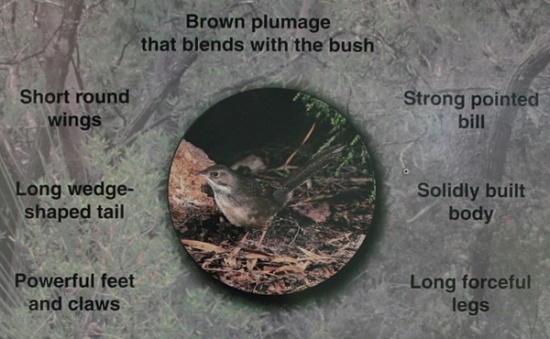(completed all sections) |
|||
| Line 39: | Line 39: | ||
{{GSearch|Atrichornis+clamosus}} | {{GSearch|Atrichornis+clamosus}} | ||
| − | + | ||
[[Category:Birds]] [[category:Atrichornis]] [[Category:Bird Songs]] | [[Category:Birds]] [[category:Atrichornis]] [[Category:Bird Songs]] | ||
Revision as of 21:50, 12 February 2017
- Atrichornis clamosus

Photo of sign by HelenB, Two Peoples Bay Visitor Centre, near Albany, WA
Identification
Size - male: 23 cm; female: 19.5 cm
Male: dark brown above, with fine black barring on back. Upper chest blackish, pale below with rufous-brown vent. Marked black and white throat pattern. Long wedge-shaped tail, often cocked.
Female: brown above, no barring. Light rufous-brown below with paler throat pattern.
Juvenile: as female, but with reddish throat.
All have a strong, pointed bill, long, strong legs, with powerful feet and claws.
Distribution
South coast of Western Australia (coastal heaths east of Albany).
Taxonomy
This is a monotypic species,[1] which was thought to be extinct until a small population (about 100) was rediscovered at Two Peoples Bay, 35 km east of Albany, in 1961. The area was established as a nature reserve in 1967, to preserve the habitat for this species, whose current status is Vulnerable.
Habitat
Temperate shrubland and low, thick coastal scrub.
Behaviour
- Very elusive birds, normally only heard deep in the scrub. Almost flightless, the bird runs fast on its strong legs, moving through the thick scrub, climbing or jumping up to the lower branches of trees, but can fly a few metres on its small, rounded wings when needed.
- Nesting: the breeding season is in the winter, beginning in May or June, when predators such as goannas and snakes are inactive. The female builds a dome-shaped nest with a side entrance, in the thick sedge, close to the ground. She lays one large egg, pale pinkish-buff in colour, with speckles. She incubates alone for about 38 days, which is about twice as long as other passerines. Total care of the nestling is by the female. The nestling fledges in 3-4 weeks, but may stay close to the mother for several months.
- Voice: a very loud, strong call. Listen to the call below.
Vocalisation
<flashmp3> Noisy Scrub Bird TwoPeoplesBay 260609.mp3</flashmp3>
Listen in an external program
Two Peoples Bay, June 2009
<flashmp3> Noisy Scrub BIrd Cheynes Beach 280609.mp3</flashmp3>
Listen in an external program Cheynes Beach, June 2009
Recordings by Andrew Whitehouse
References
- Clements, JF. 2008. The Clements Checklist of Birds of the World. 6th ed., with updates to December 2008. Ithaca: Cornell Univ. Press. ISBN 978-0801445019.
- Wikipedia
- BF Member observations
- Simpson, K and N Day. 2004. Field Guide to the Birds of Australia. 7th ed. Australia: Viking Penguin. ISBN 978-0670041800
Recommended Citation
- BirdForum Opus contributors. (2024) Noisy Scrubbird. In: BirdForum, the forum for wild birds and birding. Retrieved 27 April 2024 from https://www.birdforum.net/opus/Noisy_Scrubbird



